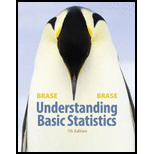
Concept explainers
Critical Thinking Let r be a binomial random variable representing the number of successes out of n trials.
(a) Explain why the
and why the sum of the probabilities of all the entries in the entire sample space must be 1.
(a)
To explain: The reason that the sample space consists of the set {0, 1, 2, …, n}, and the reason that the sum of the probabilities in the sample space is equal to 1.
Answer to Problem 22P
Solution: A variable, r, which represents the number of successes in n trials of an experiment. There are n trials, and so, the number of trials should be
Explanation of Solution
Given: Consider r to be a binomial random variable used to represent the number of successes out of n trials.
Calculation: There are n trials; so, the number of trials should be
The sample space is a collection of all the possible outcomes in an experiment. It is known that the sum of the probabilities of all outcomes should be equal to 1. Consider an example of tossing a coin. The sample space of tossing a coin is,
The probability of obtaining heads can be calculated as:
The probability of obtaining tails can be calculated as:
The sum of the probabilities of obtaining heads and tails can be calculated as:
Hence, the sum of the probabilities of the sample space is equal to 1.
(b)
To explain: The reason behind the probability,
Answer to Problem 22P
Solution: The probability,
Explanation of Solution
Given: Consider r to be a binomial random variable that represents the number of all successes out of n trials.
Calculation: The probability of r greater than or equal to 1 can be written as:
Or,
From the above, it is clear that the probability of
(c)
To explain: The reason behind the probability,
Answer to Problem 22P
Solution: The probability,
Explanation of Solution
Given: Consider r to be a binomial random variable that represents the number of all successes out of n trials.
Calculation: The probability of r greater than or equal to 2 can be written as:
Or,
From the above, it is clear that the probability of
(d)
To explain: The reason behind the probability,
Answer to Problem 22P
Solution: The probability,
Explanation of Solution
Given Consider r to be a binomial random variable that represents the number of all successes out of n trials.
Calculation: The probability of r greater than or equal to m can be written as:
Or,
From the above, it is clear that the probability of
Want to see more full solutions like this?
Chapter 6 Solutions
Understanding Basic Statistics

 College Algebra (MindTap Course List)AlgebraISBN:9781305652231Author:R. David Gustafson, Jeff HughesPublisher:Cengage Learning
College Algebra (MindTap Course List)AlgebraISBN:9781305652231Author:R. David Gustafson, Jeff HughesPublisher:Cengage Learning

